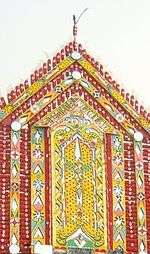Somb
| Part of a series on |
| Serers and Serer religion |
|---|
  |
|
Deities |
|
Main doctrines |
|
Sacred places
|
|
Notable figures
|
|
Relations with other religions |
|
Education |
|
See also
|
|
Somb (in Serer, also Som or Sombe) is a town in Senegal situated in the west of the country.
History
Somb figure prominently in Serer religious affairs for a long part of its history. It takes its name from the Somb tree (Latin : prosopis africana a species of prosopis[1]) the symbol of immortality in the Serer creation myth.[2] The Somb tree was used for burial purposes.[2] The wood is very strong and resistant to rot. It is the wood found in many of the Serer tumuli which are still intact after a thousand years.
The Battle of Fandane-Thiouthioune (18 July 1867) more commonly known as the Battle of Somb took place in the vicinity of this town. In that battle, Maba Diakhou Bâ tried to launch jihad against the Serer people of Sine but was defeat by the King of Sine Maad a Sinig Kumba Ndoffene Famak Joof.[3][4]
Administration
Somb is a town in the Département of Gossas, in the region of Fatick. It is part of the rural community of Patar Lia.
Geography
The nearest towns are Djilassene, Ndiayene, Ndiok Doumaleourou, Dok, Kodieri, Koral and the two historical towns of Fandène, Tioutoune (or Thiouthioune).
Famous people born in Somb
- Yandé Codou Sène (1932–2010), the Serer Diva and griot of president Léopold Sédar Senghor
Notes
- ↑ Kalis, Simone, "Médecine traditionnelle, religion et divination ches les Seereer Siin du Sénégal" – La connaissance de la nuit, L’Harmattan, 1997, p 292, ISBN 2-7384-5196-9
- 1 2 Gravrand, Henry, "La Civilisation Sereer - Pangool", vol. 2. Les Nouvelles Editions Africaines du Senegal (1990), pp 199-200, ISBN 2-7236-1055-1
- ↑ Sarr, Alioune, Histoire du Sine-Saloum, Introduction, bibliographie et Notes par Charles Becker, BIFAN, Tome 46, Serie B, n° 3-4, 1986–1987
- ↑ Klein, Martin A., Islam and Imperialism in Senegal. Sine-Saloum 1847-1914, p90. Edingburg Universuty Press (1968). ISBN 0-85224-029-5